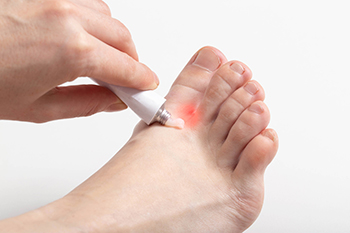
Athlete's foot is a fungal infection that typically affects the skin between the toes and on the soles of the feet. It often causes such symptoms as itching, burning, redness, and peeling skin. The condition is caused by fungi that thrive in warm, moist environments, making public showers, swimming pools, and locker rooms common sources of infection. Poor foot hygiene and wearing tight, non-breathable footwear can also contribute to its development. Relief from athlete's foot generally involves keeping the feet clean and dry, applying antifungal creams or powders, and wearing breathable shoes and socks. In more severe cases, a podiatrist may prescribe stronger medications. If you have developed this uncomfortable condition, it is suggested that you consult a podiatrist who can offer the treatment that will work best for you.
Athlete’s Foot
Athlete’s foot is often an uncomfortable condition to experience. Thankfully, podiatrists specialize in treating athlete’s foot and offer the best treatment options. If you have any questions about athlete’s foot, consult with Dr. Kendall Blackwell from InStride Wilson Podiatry Associates. Our doctor will assess your condition and provide you with quality treatment.
What Is Athlete’s Foot?
Tinea pedis, more commonly known as athlete’s foot, is a non-serious and common fungal infection of the foot. Athlete’s foot is contagious and can be contracted by touching someone who has it or infected surfaces. The most common places contaminated by it are public showers, locker rooms, and swimming pools. Once contracted, it grows on feet that are left inside moist, dark, and warm shoes and socks.
Prevention
The most effective ways to prevent athlete’s foot include:
Symptoms
Athlete’s foot initially occurs as a rash between the toes. However, if left undiagnosed, it can spread to the sides and bottom of the feet, toenails, and if touched by hand, the hands themselves. Symptoms include:
Diagnosis and Treatment
Diagnosis is quick and easy. Skin samples will be taken and either viewed under a microscope or sent to a lab for testing. Sometimes, a podiatrist can diagnose it based on simply looking at it. Once confirmed, treatment options include oral and topical antifungal medications.
If you have any questions, please feel free to contact our office located in Wilson, NC . We offer the newest diagnostic and treatment technologies for all your foot care needs.